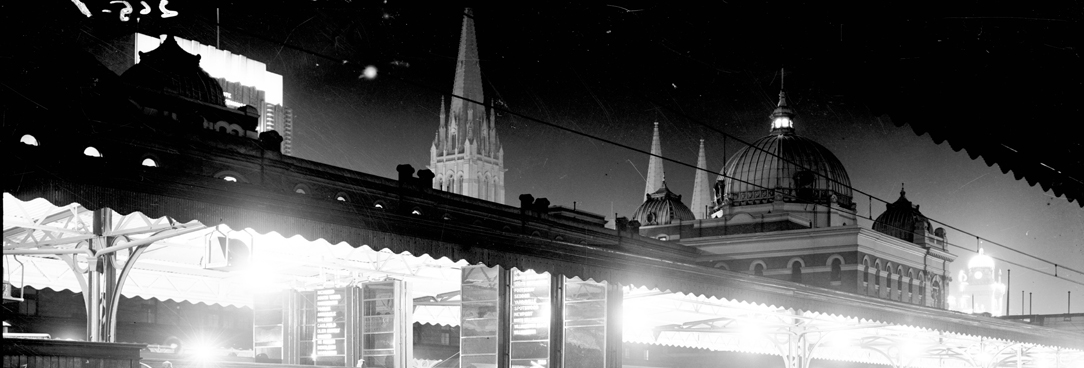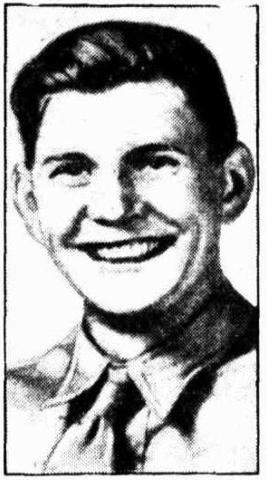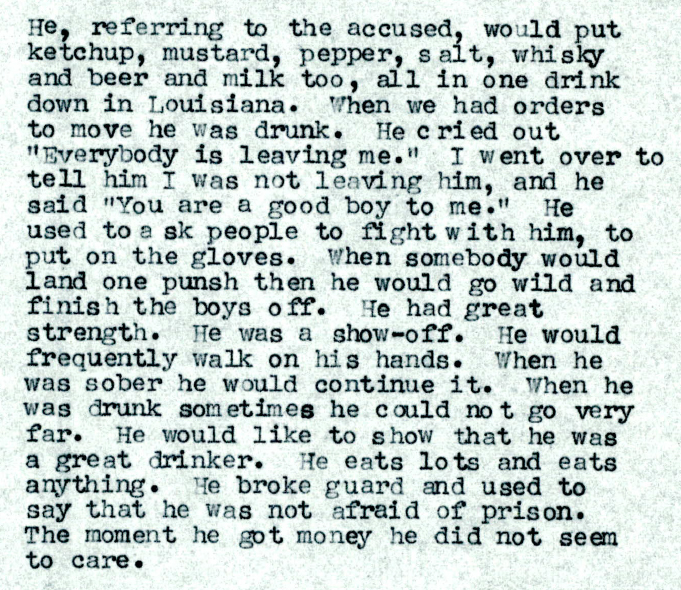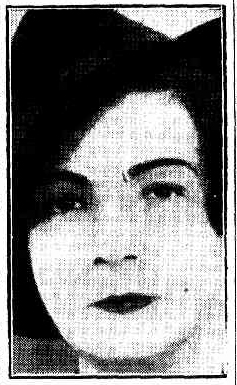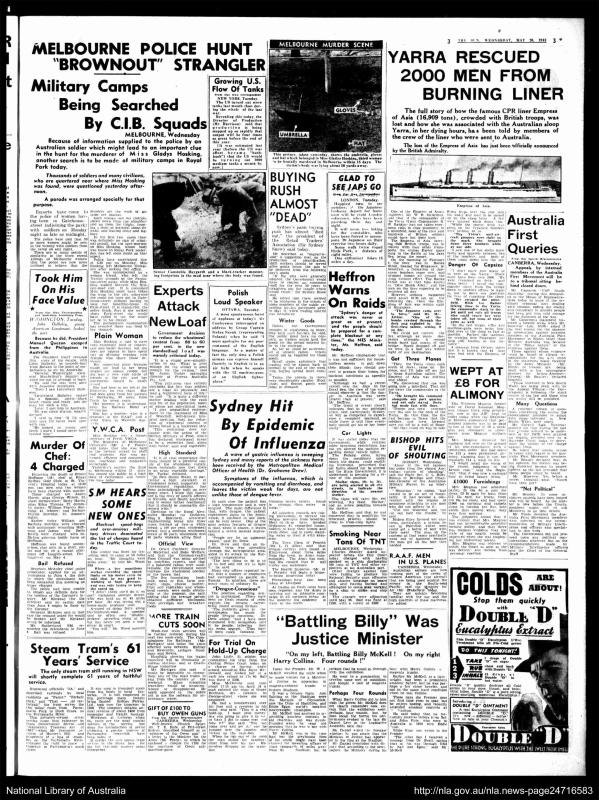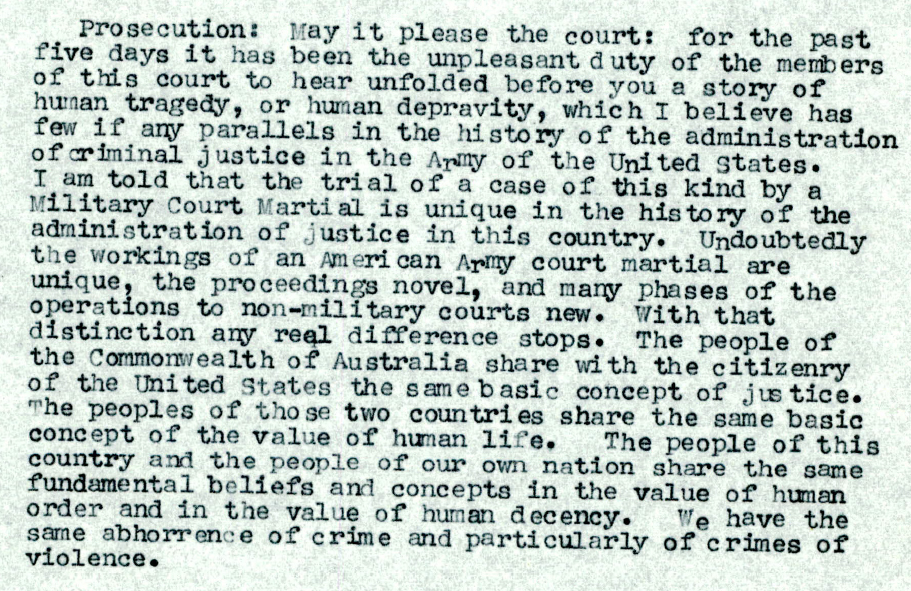
Author: Tara Oldfield
Senior Communications Advisor
Every year on the 1st of January hundreds of state archives are made public as part of Public Record Office Victoria’s annual Section 9 record openings. Under Section 9 of the Public Records Act 1973 files of a personal or private nature are closed to prevent the violation of personal privacy. Among the files made public this year are 1942-43 capital case files. Capital cases relate to those criminal trials where a sentence of death was given. This year the Victorian Government copy of the Eddie Leonski trial is included (a copy is also on open access at the National Archives). The inquest record for the victims is also held in our collection. Together with newspaper reports from the time, these files paint a sinister picture of Eddie Leonski in Melbourne in 1942.
Please note this article contains records related to murder and may be upsetting to some readers.
Eddie the American soldier
Edward J. Leonski, known as Eddie, was a Private in the 52nd Signal Battalion of the United States Military Services. He was aged 24 when he was transferred to Melbourne from Fort Sam Houston, Texas via San Francisco. He joined the military, in part, to get away from his brother and sister-in-law, the latter whom he had fallen in love with. Though he wanted an escape, he cried so much leaving Sam Houston that other soldiers had to pack his bags for him. But he was also strong, and proud of it, showing off to his fellow soldiers and challenging them to fight, often.
He was also an alcoholic. While stationed in Melbourne, at Camp Pell Royal Park, he frequented hotels around town most nights. When he drank he was known to do headstands on the bar and according to his mate Gallo:
“When he gets drunk, he talks like, you know… Like softly; it sounds like a girl to me… It is different from his usual talk.”
He worked in the Camp Pell kitchen and he was, according to her commander “perpetually in trouble,” regularly absent without leave and drunk more than the average soldier, even back in the States. When drinking, he often wouldn’t remember what had happened the night before. A description in the capital case file states:
Murders in Melbourne
At the time Eddie Leonski and other American soldiers were stationed in Melbourne at Camp Pell, women were being found strangled to death. The string of murders began on Sunday the 3rd of May at 6.45am when a man named Harold Gibson saw an American soldier looking at something in the doorway of 191 Victoria Avenue. When Gibson went to enquire what he was looking at, the soldier hurried away leaving Gibson to discover a woman lying in the doorway, she had been strangled. That woman was Ivy Violet McLeod, the first victim of the unknown man who soon became known as the “brownout strangler” in reference to the reduced street lighting due to the war.
On the morning of Saturday the 9th of May, Pauline Buchan Thompson was found murdered on her doorstep in Spring Street. Pauline was 31 years old. She was married to a police officer and had two children who were staying in Bendigo while she was based in Melbourne for work as a typist at the International Harvester Company and at 3AW Radio of an evening on the switchboard. After spending the previous afternoon with her husband and son who had been in the city, she’d gone out for a night on the town, catching up with friends and drinking at various hotels. She met an American soldier at the Astoria and spent part of the evening talking to him. That was the last she was seen alive.
Finally on Monday the 18th of May, Gladys Lilian Hosking finished her day’s work in the chemistry department of the University of Melbourne, she was employed as an assistant and secretary, and walked a short way with her colleague Dorothy Isobel Pettigrew. Gladys Lilian Hosking was a small woman of five feet, she was 40 years old with brown wavy hair and blue eyes. After bidding Dorothy farewell she continued the short walk home along Royal Parade while Dorothy headed in the direction of Swanston Street to catch a tram. While Dorothy made it home, Gladys never did. Gladys was last seen sharing her umbrella with an American soldier. Her body was found the following morning two blocks from her home, inside a fence which surrounds Royal Park. Like the other women, she had been strangled.
Eddie Leonski was camped in a tent at Camp Pell, Royal Park, very near where Gladys was found and he had been seen, covered in mud, walking back to camp from the direction of Gladys’ body the night before. His tent was searched and his muddy clothing was found. He soon confessed to police. His statements can be found within the inquest file, see below excerpts:
Statement in relation to Ivy Violet McLeod
“On Saturday May the 2nd I was drinking in the Bleak House with a number of soldiers…
My tram seemed a long time in coming. I got to thinking about how lonely I was. Then I thought about six Australian civilians who jumped me one time and checked me until I was almost unconscious. I got tired of waiting and started to walk up Victoria Street. I saw a girl standing by a doorway. She smiled. I made some comment about her bag. I took it in my hand and then gave it back to her. The girl moved back into the recess and I must have followed…”
Statement in relation to Pauline Buchan Thompson
“I remember now about the girl who was killed in Spring Street. I met her in a restaurant. She was waiting for an order. I asked her if I could sit with her. She smiled and said “Alright.” I told her that I would rather have something stronger to drink. She told me that she knew of a place. We walked around a bit. It was raining and we stood in doors. We met a soldier who showed us a place to go and get a drink. We were sitting at a table drinking. I bought a few drinks. There was a girl sitting at a table in the corner looking at me. I was looking at her. My girl wanted to shout. I told her when I went broke I would let her shout. She did shout. She was singing in my ear. She looked into my eyes, and it sounded as if she was just singing for me. She was drinking gin squash. I tasted it but it was too mild. She said that she was not married. We were talking about life. We got along swell together. She asked me if I needed any money. We sat around a while and drank. She told me that she sang. After I went broke she kept on buying all the drinks. When we left the hotel she picked up her bag. She had a nice voice. She sang as we walked along. We turned a corner there was nobody around. I didn’t see anybody. I just heard her voice. Then we came to the stone steps. They were long steps. I grabbed her. I grabbed her. I don’t know why. I grabbed her around the neck. She stopped singing...”
Statement in relation to Gladys Lilian Hosking
“On Monday night 18th May 1942, I was drinking beer in the Parkville Hotel…
On the corner I met a girl. It was a small girl. She was carrying an umbrella. It was raining and I asked her to let me walk along with her. She said ‘Alright’. We walked along the street. We came to her house. I asked her to walk on with me and show me the way to camp. She said ‘Alright.’ Soon we came to a very dark part of the street. She stopped and said ‘There’s the camp over there.’ She had a lovely voice. I wanted that voice…”
US Military Court
As Leonski was a US serviceman when he committed the murders, he was tried under American Military Law. It is the transcripts from the court that make up the bulk of the capital case file in our collection.
Leonski himself did not testify, the police instead spoke about what he had told them in his statements. The most chilling testimony came from fellow American soldier Private Anthony J Gallo. He gave his testimony on July 16, 1942, detailing his encounters with Leonski including Leonski confessing to the murders prior to his arrest. He said:
“I saw him standing in front of his tent, and he appeared to be drunk, so I stopped to talk to him. I said ‘what is the matter with you?’ He said he was going out. I said ‘Why go out? Why not go to bed? You are drunk.’ Then he told me ‘I killed, Gallo, I killed.’”
Gallo did not believe him but bought him a newspaper when he insisted.
“When I found the article, I showed it to him, and after about a minute of reading, he said, ‘Doorstep, doorstep, that is the one.’
…He said that this here second person said, ‘You have a baby face, but underneath you are vicious.’”
Gallo described how in later conversations Leonski compared himself to a werewolf and Dr. Jekyll and Mr. Hyde. He told Gallo he had two personalities. Gallo began to believe there may have been truth to Leonski’s confession after reading more about the murders.
“A few nights later – four or five or six nights later – in the paper appeared that article about an American soldier last seen with this second woman.
He said, ‘There are plenty of American soldiers; there is nothing to worry about.’
I told him ‘You have made me afraid of the darkness.’
He put his arm around me and smiled.”
Eddie Leonski was found guilty and sentenced to death. He was executed at Pentridge on the 9th of November 1942.
Death sentences and Pentridge
Also in the capital case file is correspondence between the Law Department and journalist Ivan D Chapman who was writing a book about Leonski some years later. The letter below includes a summary of other death sentences carried out at Pentridge both before and after Leonski.
"One hundred and twenty (120) persons have been sentenced to death in the State of Victoria since 9 November, 1942. Four were executed; namely, Jean Lee, Robert David Clayton, Norman Andrews and Ronald Joseph Ryan. Lee, Clayton and Andrews were sentenced to death on 6 March, 1950, and executed on 19 February, 1951, and Ronald Joseph Ryan, who was sentenced to death on 30 March, 1966, was executed on 3 February, 1967. Each of these prisoners was executed at H.M. Pentridge Prison.
The remaining death sentences were commuted – thirty four (34) to life imprisonment and eighty one (81) to varying terms in prison. One prisoner (Reginald Edward Isaacs), upon whom sentence of death was pronounced on 26 March, 1975, committed suicide in his cell at H.M. Pentridge Prison on 30 April, 1975.
Edward Kelly, Richard Deeming, Martha Needle, Colin Campbell Ross and Angus Murray were executed at the Old Melbourne Gaol on 11 November, 1880, 23 May, 1893, 22 October, 1894, 24 April, 1922, and 14 April, 1924, respectively. According to the records Deeming’s correct name was Albert Williams. Arnold Sodeman was executed at H.M. Pentridge Prison on 1 June, 1936.
The gallows, beam, trap, lever et cetera used at the Old Melbourne Gaol were installed at H.M. Pentridge Prison during 1932. They were removed from H.M Pentridge Prison during May, 1975, and are at present stored in the Old Melbourne Gaol."
No doubt women of Melbourne could sleep easier after Leonski's execution.
Resources
• The Capital case file, VPRS 264 P1 Unit15 EJ Leonski 42/6843 can be ordered for viewing in our North Melbourne reading room by filling in this contact form.
• The National Archives copy can be found online, search Leonski at http://naa.gov.au/
• The Inquest, VPRS 24 P0 Unit1642 1943/68, can be ordered via the catalogue here.
• Trove is also a fabulous resource to see how the Leonski case was being reported in the papers at the time.
Material in the Public Record Office Victoria archival collection contains words and descriptions that reflect attitudes and government policies at different times which may be insensitive and upsetting
Aboriginal and Torres Strait Islander Peoples should be aware the collection and website may contain images, voices and names of deceased persons.
PROV provides advice to researchers wishing to access, publish or re-use records about Aboriginal Peoples
